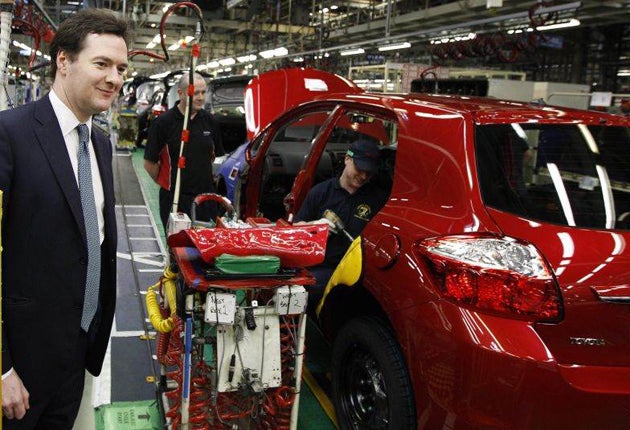To offshore or not to offshore? That is the question
Some motor industry firms are scaling back offshore production, but 'onshoring' may not have the last laugh


Bring it back! One of the brightest stars in the UK economic firmament this year has been the strength of the motor industry. Car sales have been extremely strong, up 12 per cent last month, the only major market in Europe that is up this year. But production has also been strong, almost eliminating the gap in trade in motor vehicles that has persisted for a generation. We still import more cars than we export, but we tend to export expensive models and import cheaper ones.
We do, however, need to import a high proportion of components from abroad to make these cars, and there is now a drive to boost local component production, to bring it back onshore. That is part of a much wider change described by the ugly word “onshoring”, the reverse of the offshoring that has swept through much of industry in the West, in services as well as manufacturing. It is a word new enough for its definition not to have settled down yet, but it is one we are going hear much more of in the months to come.
Examples abound. In the service industries one of the most notable examples of onshoring was Santander moving its call centres back from India to the UK. In the US Wal-Mart has pledged to buy an additional $50bn of US-made goods over the next decade – though relative to the size of its sales of nearly $500 billion a year that is quite small.
In garment manufacturing, the best European example of keeping production here is Zara, the Spanish-owned fashion chain. It produces some 10,000 new designs a year. But the thing about fashion is that you don’t know which lines will be winners until they walk off the racks. So instead of having to cope with the long shipping times for goods made in Asia, much of production is in automated factories in Spain. Goods that are selling fast are then finished in small workshops in Portugal and Galicia, stuck on lorries, and are in the shops in northern Europe in 48 hours.
As with all new economic trends, you have to be cautious about the scale of what is happening. In Britain the evidence of onshoring is still bitty. There is a nice story about Symington’s, a Leeds food company, moving its noodle production back from Guangzhou to Yorkshire. In Wales, the production of the Raspberry Pi computer is being moved back from China to Pencoed. There are examples of production not being moved overseas because the cost advantage is minimal when set against the advantage of being close to markets, a case here being the production of titanium dioxide at the giant Huntsman plant on Tyneside. Apparently they thought of moving production to China until they realised that labour costs, which of course were higher here, were only a small part of the total costs.
Against this, though, there are still examples of manufacturing jobs moving offshore. Earlier this year Caterpillar announced that it was creating 200 new service jobs in Belfast, which sounds fine until you note that it cut 760 jobs in Northern Ireland a few months earlier, moving generator production to China.
Still, if you net the losses against the gains, US manufacturing jobs have been rising since 2010 and manufacturing jobs here have at least stopped falling, levelling out at about 2.5 million, against some 4.2 million in the late 1990s. As wages increase in the emerging markets – and it is projected that manufacturing wages in Shanghai, the highest in China, will pass those in the US within five years – the cost advantage will disappear. Offshoring will continue, but increasingly the process will not be a one-way street.
How to value Royal Mail?
Has Royal Mail been sold too cheap? Probably, but the problem with any share float is that you don’t know what something is worth until you test it. There are three main uncertainties. One is the market. If there were something akin to Lehman Brothers’ collapse, all share prices would collapse too. The second is fashion. Facebook was a highly fashionable investment proposition, so much so that it was initially overpriced. This one seems to have caught the public mood, but it might not have done. And the third is the difficulty of benchmarking a company. There are other mail services, but their balance of business and prospects are all different.
So what do you do? You either sell off shares in small tranches, as we have with Lloyds Bank, and spread the risk. (Actually Lloyds shares are now below that issue price.) Or you can do what they have done and accept that investors may get a sudden profit.
Join our commenting forum
Join thought-provoking conversations, follow other Independent readers and see their replies
Comments